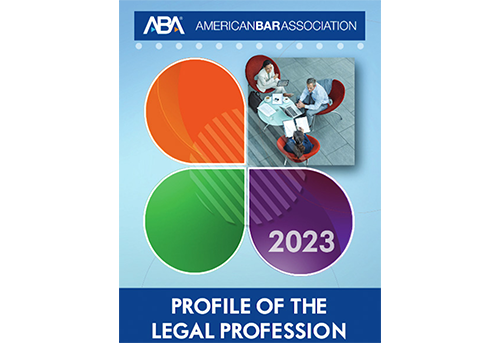2023 'Profile of the Legal Profession' report spotlights the scarcity of legal aid lawyers

The ABA released its annual "Profile of the Legal Profession" report Thursday, and it offers a sobering look at the dearth of civil legal aid lawyers in the U.S.
The ABA released its annual Profile of the Legal Profession report Thursday, and it offers a sobering look at the dearth of civil legal aid lawyers in the U.S.
Its findings were the subject of the ABA webinar “Civil Legal Aid in America: A Challenge for Equal Justice” on Thursday morning that marked the publication of the report.
Lincoln Caplan, a Yale Law School lecturer and author, moderated the panel. He cited findings from the report, which found that in the past decade, the number of full-time legal aid lawyers has actually increased.
“But some sobering news is that of the 1.3 million lawyers in the United States, only around 10,000—that’s barely three-quarters of 1%—are full-time legal aid lawyers. It’s no wonder that of the people who are poor and economically struggling in the United States, only around 8% succeed in getting that help,” he said.
Jeniece Jones, executive director of the Public Justice Center, a civil legal service provider in Maryland, said many people have to go it alone as they struggle to stay in their homes, keep custody of their children, or fight for fair wages or benefits.
“Folks get a lot of paperwork—a third, fourth, fifth notice—and they’re not even sure what they’re looking at,” she said. “The importance of civil legal aid is just having somebody on their side—somebody that’s going to stand with them.”
For Radhika Singh, National Legal Aid & Defender Association vice president for civil legal services and strategic policy initiatives, it’s a matter of fairness. She suggested people who come home to find themselves locked out of their homes are often shut out of the justice system too.
“We’ve put those systems in place without thinking of them and without consulting them, and that is not what a democracy is,” Singh said.
The report said uneven legal aid funding across cities, counties and states is part of the problem, and the profession has struggled to attract lawyers to rural parts of the country where there are severe shortages of lawyers.
Another issue is pay.
Rebecca Sandefur, a sociologist and director of Arizona State University’s Sanford School of Social and Family Dynamics, said that people coming out of law school may have $150,000 or more of debt.
“They would also like to have families and buy houses and have car payments,” she said. “Legal aid lawyers don’t get paid very much. You have all of that debt, and you want to have a life, and you’re getting paid $52,000 a year.”
Sandefur said the public should force their representatives’ hands and make the lack of legal aid an election issue.
“This is a democracy, and these are our laws. We should be pressing our representatives to make justice accessible,” she said.
ABA President Mary Smith underlined the importance of the issue in an introduction to the report. She cited Legal Services Corp. findings suggesting 92% of low-income Americans tackle civil legal issues without sufficient help.
“This sheds light on their distribution nationwide and scarcity, the profound impact of their role, and the urgent need to increase their presence in many communities,” Smith wrote.
The profile offered a close-up look at the regions where the situation is most dire, contrasting them with better-served areas.
For instance, it found that there were 1,300 legal aid lawyers in the New York City metropolitan area, and that New York state has more legal aid lawyers (1,700) than any other state. In Carson City, Nevada, however, there was only one.
Meanwhile, Yuma, Arizona, which has a population of 100,000 people, was getting by with one legal aid lawyer. Ocala, Florida, a city of almost 400,000, had three.
Even though Mississippi has the second-highest poverty rate in the U.S., according to the report, with 18% living below the poverty line, there was only one legal aid lawyer for every 10,000 people in poverty. Georgia only has 1.3 legal aid lawyers for every 10,000 living in poverty. Meanwhile, Arizona has 1.2 legal aid lawyers per 10,000, the report states.
Overall, the report found that across the U.S., there are about 3 legal aid lawyers per 10,000 people living in poverty.
For low-income people struggling to get legal help, finding lawyers in big cities is challenging. But the report adds: “It’s almost impossible in some small, rural cities and counties with only one or two paid legal aid lawyers—and some with none.”
Other findings
Delving deep into statistics and trends, the report touches upon nine other topics, including demographics, wages, legal education, women in the legal profession and well-being.
Men still outnumber women in the profession and the percentage of female lawyers has “increased slowly,” the report suggests. The number of female lawyers grew by 5 percentage points in the past 10 years, from 34% in 2013 to 39% in 2023.
Citing data from the ABA National Lawyer Population Survey, the report says the percentage of lawyers of color has almost doubled in the past decade.
For the 31st year in a row, the share of law firm partners of color increased, and the number of openly LGBTQ lawyers rose in law firms too, according to the report, which cites data from the 2022 National Association for Law Placement Report on Diversity in U.S. Law Firms.
However, while there were modest gains in the profession for Asian-American and Hispanic lawyers, the percentage of lawyers who are Black (nearly 5% in 2023) and Native American (one-half of 1%) is almost unchanged in a decade.
The report dedicates an entire section to well-being. It found lawyers are twice as likely as people who aren’t lawyers to have suicidal thoughts. It cites a study in the journal Healthcare titled “Stressed, Lonely and Overcommitted: Predictors of Lawyer Suicide Risk,” which found the risks are more pronounced among young lawyers and those who work long hours.
“The survey of 1,962 lawyers found that 8.5% reported thoughts that they would be better off dead or of hurting themselves,” the report states. “By comparison, 4.3% of all adults in the U.S. have thought about suicide, according to a recent national study from the Centers for Disease Control and Prevention.”
There was welcome news for lawyers on the financial front.
According to the U.S. Bureau of Labor Statistics, in 2022, the average wage for lawyers rose 10.6%, the biggest one-year increase in two decades and higher than the rate of inflation.
An ABA press release is here.
See also:
“‘ABA Profile of the Legal Profession’ report shines a light on judicial diversity”


